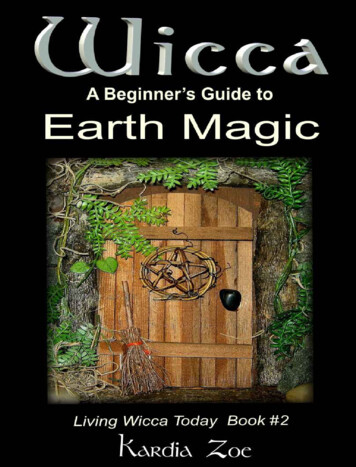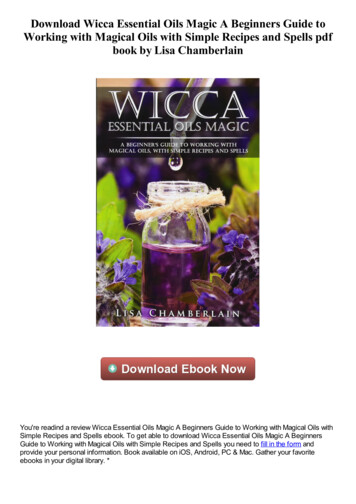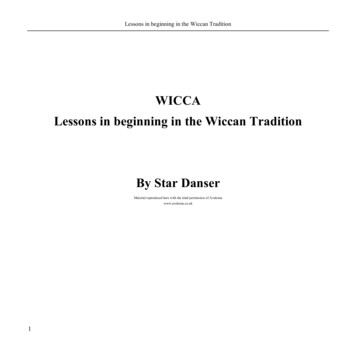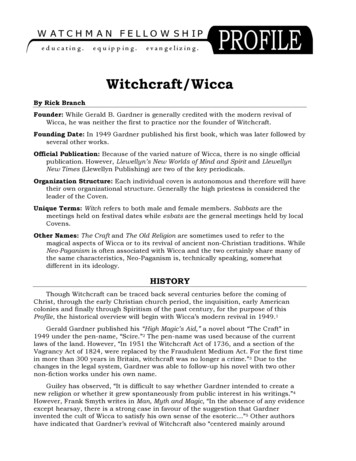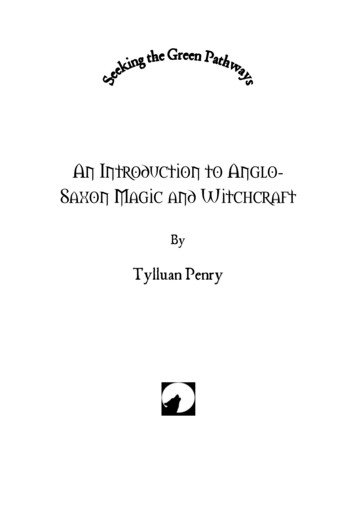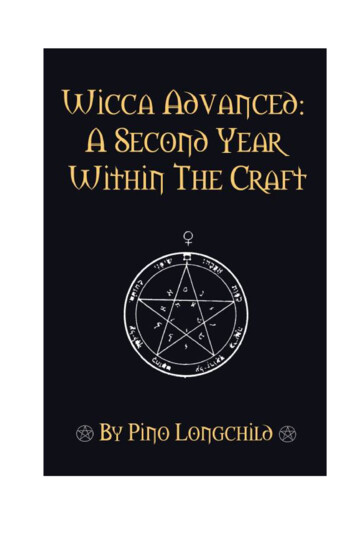
Transcription
Wicca Advanced:A Second Year withinthe CraftbyPino Longchild1
This work is copyright of Pino Longchild, 2007. No part of this book may bereproduced or utilised in any form or by any means, electronic or mechanical,including photocopying, recording or any information storage and retrievalsystem, without permission in writing from the author.2
AcknowledgementsA huge debt of gratitude goes to Deirdre Hebert who extremely generouslyvolunteered to read and edit the entire manuscript. I don’t know what I wouldhave done without her keen eye for all manner of grammatical corrections, thechanges she made to cumbersome phrases, her pointing out of factual errors andher suggestions on how to make some of the sections clearer.Cassandra Carmentisis, Asphodel (aka Beith), the moderator and mentor teams(both past and present) on the www.magickaschool.com Forum are deserving ofmention as well, for without their sterling work I would not have had the time todevote to writing that I have needed. They have all helped create a very successfulOn-line community and I am very grateful for all they have done.I would also like to acknowledge those students at Magicka School who havewritten to me from time to time, pointing out inconsistencies and things that werevague in the On-line course of Wicca Advanced.Finally, great thanks are also due to my wife, Chantal Santos, with whom Idiscussed many of the ideas within the book.Please Note: All dates are given using the convention CE (Common Era,equivalent to Anno Domini or AD) and BCE (Before Common Era, equivalent toBefore Christ or BC).3
PrefaceIt is hoped that Wicca Advanced will provide students with the means to furthertheir Wiccan education in a deep and meaningful way. Wicca Revealed gave itsreaders the basic Wiccan framework of living, the Esbats and Sabbats and thefundamentals of some of the magical arts. Wicca Advanced builds on this andprovides the means to explore in detail a variety of important skills practiced bymany Witches.The work has a strong emphasis on service to others. Although such things asdivination, Astrology, herbalism and healing crafts can be practiced alone, and forthe benefit of the individual, they are also powerful tools that can achieve thebetterment of a community, be that the community of a family or a village or atown.Wicca Advanced closely follows the On-line course of the same name and it hasbeen made available in the hope that it will provide a useful complimentaryresource to the On-line offerings. No longer will students have to resort toprinting off the web pages and re-format them in a word-processor. The book’sorganisation also means that students will be easily able to revisit areas that theywish to look at again.The original twelve lesson structure has been kept throughout. Most lessonscontain a main topic as well as a research project and exercises. Footnotes can befound at the end of each chapter, as can any appendices. For reasons ofproduction costs, the course exams have been omitted.Pino LongchildDecember 3rd, 20074
ContentsUse of this Book, P.9Chapter One, P.11DivinationThe Point of Divination, How Divination Works, Akashic Records andSynchronicity, Precognition, Fixed Patterns and Combinations, The Tarot,Palmistry, Skrying, Runes, Pendulums, Tea and Molten Wax, The I Ching, CareIssues.Research Project: Exploring Divination.Exercises: Regression Exercise, Invocations and Spells to be Used BeforeDivination.NotesChapter Two, P.33Celebrating the Cycle of Human LifeWiccaning, Handfasting, Funeral Rite.Research Project: Poetry for Rites, Exploring the Legalities.Exercises: Past Life Recollection, Spell of Happiness and Success.NotesChapter Three, P.55Ceremonial BasicsHerb Basics, Herbs and Astrology, The Planets and Associated Plants, Star Signsand Associated Plants, Body and Star Sign Correspondences, Parts of the Bodyand Planetary Correspondences, Herbal Preparations, Some Common Herbs andtheir Uses.Research Project: Beginning a Herbal, Creating a Herb Garden .Exercises: Ritual Baths, Incense and Circle Casting, Herbal SpellworkNotes5
Chapter Four, P.89Studying Further the Art of MagicFurther Magical Theory, The Powers of the Sphinx, Sex Magic, Use of theScourge, Talismans and Amulets, Evocation of Spirits, Magic of Contagion.Research Project: The Timing of Magic, Planetary Square Research.Exercises: Using a Variety of Pentagrams.NotesChapter Five, P.121The Kabbalah and MagicWhat is the Kabbalah? The Kabbalah and the Four Elements, the FourKabbalistic Worlds, How Witches can use the Kabbalah, the Tree of Life and theTarot.Research Project: Kabbalistic Correspondences.Exercises: Getting to know the Tree, Reviewing Magic in the Light of the Tree.NotesChapter Six, P.143Exploring the Planes of LifeA Wiccan Pillar of Balance Ritual, Travelling in the Higher Planes, Travelling as aSimulacrum, Exploring the Planes of Existence on the Spectrum ofConsciousness.Research Project: Finding Out about the Moon.Exercises: Relieving TensionNotesAppendix: The Pentagram of Life.6
Chapter Seven, P.165Astrology, Part OneThe Basic Framework, The Planets, Dignities, Exaltations and Detriments, TheZodiac, Houses and Qualities, Aspects, Creating a Natal Chart.Research Project: Personal Astrological Data.Exercises: Attunement to the Planets.NotesAppendices: Form to Aid the Creation of a Natal Chart, Table of LongitudeTime Correction, Acceleration of the Interval.Chapter Eight, P.197Astrology, Part TwoFinding the Position of the Planets at Birth.Research Project: Progressing a Natal Chart.Exercises: Planetary Squares and Sigils.NotesAppendices: Blank Chart, Form to Work Out the Planets’ Positions at Birth,Planets, Triplicities and Quadriplicities, Aspect Table.Chapter Nine, P.233Psychic PowersAdvanced Sensory Exercises, Experience Beyond te Physical Senses, Post orRetro-cognition, Precognition, Clairvoyance, Telepathy, Psychokenesis.Research Project: The Challenge from the Sceptics.Exercises: Developing ESP Skills.Notes7
Chapter Ten, P. 249Crystal CraftColour, Piezoelectric Properties and Effects on the Body, Chakras and UsingCrystals to Heal, Crystals and Magical Practice.Research Project: Collecting Crystals.NotesAppendices: Preliminary Questionnaire, Patient’s Health QuestionnaireChapter Eleven, P.275Sex and the Great RiteThe Great Rite, Symbolic Version, Actual VersionNotesChapter Twelve, P. 285A Rite of PassageRites, Skills, Self Development, Green Witch, Setting Up and Running a Coven.Research Project: Designing a CeremonyNotesReading List, P. 2998
Use of this BookWicca Advanced is laid out in twelve lessons or chapters. Each chapter isintended to provide the basis for one month of study and activity so that theentire course takes twelve months to complete. To this end, the reader will find ineach lesson an initial study section followed by a research project and exercises.Readers of this book will find much follow up material and support atwww.magickaschool.com.9
Chapter One:Divination10
Divination“Divination is the most sensitive, difficult and perilous branch of Magick.”“The abuse of divination has been responsible, more than any other cause, for the discredit intowhich the whole subject of Magick had fallen”.Aleister Crowley, The Book of Thoth, p. 253.Welcome to the Class!In this lesson you will learn about the most popular methods of divination.Continuing on, there is a research project for you to complete.There are also two lesson related exercises for you to work on.Next you will find a reading list to help broaden your knowledge.Finally, there is a blessing.DivinationIn this lesson I will consider the point of divination, examine how it works,consider some general methods of approach and look at some of the betterknown divinatory practices. First though, let’s seek to define the term.Divination comes from the Latin word divinatio which means the power offoreseeing. However, it is not an easy thing to characterise and has manydefinitions. Aleister Crowley described it as reducing to the use of two questions:“Of what are things composed?” and, “How shall we combine them to ourgreater advantage?” [1]. The Farrar’s conceived of divination as being“clairvoyance using tools” where it “is the art and science of being aware of facts,objects or situations by psychic means when they are not available to ordinaryawareness” [2]. For famous Golden Dawn Magicians, the Ciceros, it is “the art ofuncovering the divine meaning behind chance events” [3]. And for Starhawk “alldivinatory techniques work essentially to focus awareness and engage in theheightened intuition and perception that are possible in trance. Today thesetechniques are not used for “fortune telling” but as methods of spiritual andpsychological counselling” [4]. If we were to draw these together we canunderstand that divination allows us to take an overview of a situation or a thing,to a degree that is not normally possible, and, using this knowledge as a basis, itallows the diviner to see a future progression. This information is then offered tothe seeker as analysis and advice.The Point of DivinationIt is commonly argued that there is no point in divining the future as knowingwhether good things will happen spoils their surprise and foreknowledge of bad11
events creates worry. However, many of us plan for the future and use the rangeof available resources to inform our decisions. Put into this context, divinationprovides yet another tool that can aid us in how best to deploy our assets and canbe seen to have validity.How Divination WorksThere are several common notions about how divination functions. In thissection some of the better-known viewpoints are considered.The Akashic Records and SynchronicityGenerally, occultists believe that there is a repository of all human experiencesthroughout past ages. These are known as the Akashic records and are similar towhat C. G. Jung termed the “collective unconscious”. For Jung this existed belowthe level of our personal unconscious and was populated by the experiences of lifeembedded throughout human history. This stratum of consciousness is likelycommon to many mammals and has been shown by scientists to exist in cats.Appalling as it will seem to many, cats reared in a laboratory had the part of theirbrain removed that prevents them from acting out dreams. These cats had neverleft the windowless room that they had been born in and had never seen any otherliving creature. However, the actions that they carried out in their sleep wereidentical to cats that hunt birds in the outside world. This proved that the cats hadmemories and patterns of behaviour that were inherited. However, these ways ofbeing existed below the level of the cats’ waking consciousness [5].One of the lessons of occult philosophy is that ultimately all existence is one.This is echoed in psychology, where it is believed that at a deep level humans areconnected by a great sea of collective memories, containing all human knowledgeand all human behaviour. On a conscious level we are individuals, but, in theunconscious, we are at some level all joined.Witches access the Akashic records in a number of ways, most commonlythrough meditative trance or through the use of intermediary forces such as one’sHoly Guardian Angel or other spiritual guides (these are discussed in detail in laterchapters). This is the reason why many who practice divination will say a prayer orperform a short magical technique before they start calling on divine guidance.There are two types of divinatory tools that allow access to the Akashic records;those that help to induce a state of trance, and those that use a combination ofobjects that can be examined. For example, crystal balls and black mirrors are usedto aid emptying the mind and allow it to develop a light trance, whereas Tarotcards, runes and yarrow sticks are obviously divination tools that involve the useof permutations. Sometimes both types of approach are used together; forexample, some Tarot readers induce a trance state before reading the cards.How divinatory tools function with regard to the Akashic records is perhapsbest explained by the theories of Jung. According to his ideas, some symbols12
manifested themselves in waking conscious life in the form of a synchronicitousevent. For example, Jung felt that one happening of this kind might be a clockstopping at the point that someone died. He perceived this kind of event to bemore than just mere coincidence. Could it be then that when the diviner caststheir cards, or stones, or yarrow sticks, that the way they fall is more than just arandom happening? Perhaps the patterns they fall into, and the interpretation theyare given, are synchronicitous events with meaning and import, allowing thediviner to connect to the collective unconscious or Akashic records. The divinerthen uses his or her intuition to decide what the future will hold, based on theirunderstanding of all past and present events pertaining to the matter in hand.A common criticism of divinatory practice based on combinations of objects isthat it is extremely unlikely that the same pattern that the diviner has cast willappear twice over the same issue. But those who make this point have notunderstood the nature of synchronicity - it is of the moment, and when themoment has changed the circumstances have changed. The pattern of the objects,and the reading that is generated from them, will be different.PrecognitionThere is another way that divination may be able to work and that is based onactually seeing the future.That this may be possible is indicated by scientific research into precognition,which can be defined as seeing that an event is going to happen. Around theworld there are a number of researchers looking into the nature of consciousness.Scientists, including Dean Radin of the Boundary Institute, Los Altos, California,have been showing individuals a series of random pictures, the majority of whichare pleasant or neutral scenes, interspersed with a few horrific or erotic photos.The viewers are shown the images one by one and their brainwaves constantlymonitored throughout the experiment. What the results consistently show is thatan individual’s brainwaves and sweat patterns change just before the horrific orerotic photos are shown. Somehow the brain knows something unusual is aboutto happen before it takes place [6]. This is but one of many experiments that leadto the conclusion that at some level all of us have precognition. It is important tonote that these manifestations of precognition are below the threshold ofconsciousness. That is, the individual is not consciously aware that there havebeen changes in their physiology. Despite this, the research does not rule out thepossibility that it may be possible for individuals to consciously experience futureevents and recognises, in fact, that there are numerous anecdotal reports in allcultures and throughout all times that precognition occurs.However, there are two ways of regarding the future: one is to see that it has afixed existence; the other is to see that are an infinite range of possible futures thatmay or may not take place.There are a number of scientists who believe that the future already exists andthat there is only one possible future. Some seek to base these assertions on13
Einsteinian Physics [7]. One of the conclusions that Einstein’s calculations leadsto is that all of our futures already exist, as do our pasts. Our consciousness merelyfloats along a line that is already drawn, experiencing events that have alreadyhappened as if for the first time. Everything is cut and dried and free will is anillusion, created by the limitations of our mind and the way it processesinformation. This view is based on the logic of the Space-Time Continuum. Just asan object exists away from us, so does our future, and we merely step into it,despite all our ideas to the contrary that we have control over what we do. If thisis true, and if one had the right skills to access this information, then it would bepossible to accurately tell someone their past and their future.Another scientific view of the future is probabilistic, founded on the idea thatthere are a range of future outcomes [8]. This is based on the so-called“Copenhagen Interpretation” of Quantum Theory. According to thisinterpretation, an unobserved quantum system remains in an uncertain state ofmany different possibilities. Observation causes "collapse" into a definitecondition, which is chosen at random from among the possibilities provided. Ineffect, consciousness causes patterns to reduce from uncertain states into definitestates. This has led some to conclude that there are an infinite variety of possiblefuture outcomes depending on our choices. In this view of the future free willexists as we choose which possible future to create. Perhaps then, one may havegenuine precognition of a possible future event, which may or may not take place,depending on choices made [9].Either of these scientific views allows for the possibility of precognition andfor divination; with regard to the first view, the future is fixed and knowable; withthe second a range of possible futures can be viewed. It may be then that divinerswho claim they are seeing the future really are able to utilise their methods to dojust that. However, they are not compatible, one or the other must be wrong;either the future is fixed or either it is probabilistic.Fixed Patterns and CombinationsAnother way of explaining how divination works is that certain patterns andcombinations of objects have been observed over time to indicate that there is thepotential for certain events, or that such events are extremely likely. This argumentis of particular importance to Astrology (considered by itself in other chapters)and Palmistry, although it can be also be used to partly explain other forms ofdivination as well. In Astrology combinations of planets, stars and constellationsare compared to previous patterns; judgements are then made as to their meaning.Similarly, in Palmistry, the reader knows already that certain features generallymean certain things and indicate the likelihood of them happening. With boththese methods no reference is made to the Akashic records, and they also allowfor free will as the combinations observed reveal only tendencies (some morelikely than others) which may, or may not, come to pass.14
Proponents of this style of divination talk of the similarity between its methodsand those of science. Like weather forecasters and the financial industry, pasttrends and patterns are analysed on which to base predictions of future events.Some may object that divination based on these methods is a false art, saying thatthe fundamental difference between these two examples is that the quality ofinformation upon which they base their predictions is more worthy, andfurthermore that the success of their predictive technologies can be verifiedscientifically. Yet it is a common anecdote in the financial world that buying sharesbased on a blindfolded individual throwing a dart into a list of companies is just assuccessful over time as the biggest and brightest of investment companies buyingshares based on their “scientific” predictions.SummaryIt can be seen that there are four possible foundations for how divinationfunctions: An overview of the past and present may be used to predict the future.The future is already written and viewing it is possible.Knowledge of the future may be accomplished by viewing one or more ofa limitless number of possibilities.Past data about combinations of objects may be used to extrapolate alikely course of events.All but the second approach allow for free will; for proponents of thisviewpoint the future is fixed and because of this would have to be completelyknowable to those that can access it. Perhaps, tellingly, a criticism that can belevelled against this declaration is that if this is the case how can a diviner, whoclaims to base their practice on this assertion, ever be wrong?Approaches to DivinationBefore we look at the variety of divinatory tools let us first examine the generalstyle that different diviners use. Basically they fall into two categories; those thatask their clients, or querents, what they have come for, and those that tell theirclients why they have come. This difference in approaches can be hotly debated asone accuses the other of not being correct. I will not enter into polemics here butwill give you the information you need to decide for yourself. The issues basicallyboil down to two points:1. Some argue that if a diviner doesn’t ask why a client has come thenobviously the divination breaks down if they are not correct in their interpretationand are unable to give the exact nature of the enquiry, or at least discuss it ingeneral terms.15
2. On the other hand, to many people, asking the client the nature of theirenquiry seems unauthentic and smacks of charlatanism.However, underpinning both these points of view are wider methodologies:When those that ask the querent of the nature of their enquiry are successfulthen an issue is discussed interactively. The diviner plays the role of facilitatorproviding a Forum for the client to discuss their issue and helps them workthrough a future solution of their own based on how the cards are interpreted.This method requires the diviner to have a great deal of experience of life, anability to relate to others, intuition, an ability to tailor advice to an individual’sneeds, and the skill to facilitate a client’s working through an issue. The bestdiviners in this method have these skills innately, although they can all be learntover time. The draw back with this method might be that the diviner spends theirtime asking leading questions to ply information from the client, and, having donethis, is then unable to give any beneficial lead as to how an issue may be resolved.The client then leaves feeling disillusioned, cheated, and with the feeling that theirissue hasn’t been dealt with successfully.In the second instance, when a diviner literally tells of what they see, the clientgains confidence in the diviner’s skill at being able to tell what the issue is, as wellas its details and circumstances, and feels an assuredness in the predictions of thefuture developments of the matter. This method relies on the diviner having ahigh level of intuitive or psychic ability. In the past, noted diviners used to say thatthis could not be learnt; however, many in the psychic fraternity now believe thatall of us are psychic to some extent and that these abilities can be developed andheightened. The drawback of this method can be that the querent does not havean interactive experience; they are not asked for information or an opportunity todiscuss their feelings. They have participated passively, listened to what the seersays and then left. Although the client may have been enormously impressed withwhat they regard as the diviner’s psychic ability they have not worked through anissue for themselves. In some circumstances this can mean that they disassociatefrom the issue and rely too greatly on others to sort their life out.Both approaches have advantages and disadvantages for the reader and thequerent, although, as we have seen, both can be made to work and have validity.At the end of the day the diviner must decide for themselves which method theyhave the skill for, if indeed they have the skills at all. There will be people who areunable to use either approach successfully. On the other hand, the finest readershave both sets of abilities and often combine approaches.Various Divinatory PracticesIn this section of the lesson we will now turn our attention to some of themore well known methods of divination.16
The TarotFor Wiccans the Tarot is perhaps the most widely used of divinatory tools. TheTarot can be defined as a set of seventy-eight cards of an ancient provenance.Twenty-two of these are trump cards and are known as the Major Arcana. Each ofthese has a title such as The Fool, The Magician, The High Priestess, The Moon,The Sun and The World etc. There are also fifty-six other cards that make up whatis referred to as the Minor Arcana. These are divided into four suits, mostcommonly as Wands, Cups, Swords and Pentacles. Each suit has numbered cardsfrom two to ten, they also have an Ace and four court cards generally (but notalways) referred to as King, Queen, Knight and Page.Tarot cards can easily be obtained from major book sellers and occult specialistshops; both On-line and in the real world. In some quarters there used to be anotion that Tarot cards should not be bought and that one should wait to receivethem as a gift. Romantic as this notion may seem, in reality it makes no differenceto the card’s effectiveness whether you bought them on sale from Amazon.com,or received them as a gift from a great aunt who has practiced divination for half acentury. It is what you do with them that counts.Broadly speaking the Tarot has two uses; it is a spiritual and self help tool, andit is a method of divination. However, not every Tarot is designed to have a deeprange of uses. Many are little more than a showcase for an artist’s skills, althoughadmittedly lovely to look at.For a Tarot to be effective it must have a system of symbols, but symbols inthe Jungian sense of the word. Jung defined a symbol as “a term, a name or even apicture that may be familiar in daily life, yet that possesses specific connotations inaddition to its conventional and obvious meaning it has a wider ‘unconscious’aspect that is never precisely defined or fully explained. Nor can one hope todefine or explain it. As the mind explores the symbol, it is led to ideas that liebeyond the scope of reason” [10]. Symbols that can be defined as this thereforehave mind enhancing powers that expand the range of its activity. Tarots that havesuch symbolic qualities include the Rider-Waite Tarot, the Tarot of Marseilles andRobert Wang’s Tarot of the Golden Dawn. There are, of course, others of valuetoo, but if one of these is chosen it will make an ideal place to start.Tarot symbolism is complex and for many presents significant initialdifficulties. These can be overcome by working with the cards through meditationor divination, as well as studying their imagery over a period of time. Little by littlethey will reveal the meaning that they have for you. Quite literally the Tarot can beseen as a symbolic representation of everything in existence, representing theforces of life and how they interact in various ways. Because of this it is able towiden the individual’s view of the world and show them their place within it.There are a variety of approaches to using the Tarot for divination and aninfinite amount of divinatory spreads to use. At first, beginners are advised to usethe well known Celtic Cross spread made popular by A.E. Waite, one of the17
creators of the Rider-Waite Tarot (the other being the artist Pamela ColmanSmith):The Significance of the Card Positions1. The Significator-This card shows the general atmosphere and influences thatsurround the question. Some readers choose this card to represent their client;others just deal the card out as it comes.2. This card is laid across the Significator and is always read as if it is the right wayup. This card represents the specific forces of the moment that affect the issue bethey opposing or otherwise.3. This is the basis of the matter. These are the things that have happened in themore distant past.4. This is what is behind. These are the things that have happened in theimmediate past.18
5. This is the crown of the matter. This card shows things that may be coming inthe future.6. This is in front. This card shows the immediate next turn of events.7. These are the fears. This card shows the individual’s fears about a matter.8. Environmental factors. This card represents the influences of family, friends orcolleagues.9. Hopes. This is what the individual hopes to be the outcome.10. Final outcome. This card tells of what the end of the matter will be.Most decks of Tarot come with a little booklet that explains the divinatorymeanings of the cards. These should be learnt; it is most important though that acard reader builds up their own understanding of the cards based on the meaningsof its symbols and how it appears in divinatory spreads. This is something thattakes time and to aid development it is a good idea to start a notebook where eachcard has a page devoted to it. Over time patterns of use and meaning will emergethat will provide the diviner with the knowledge they need for an in-depth Tarotpractice.PalmistryPalmistry is commonly known as the skill of divining the future based on anindividual’s palms, although many readers will look at the whole hand.It is sometimes also referred to as hand analysis or Cheiromancy (orChiromancy) the latter term taking its name from the Greek words for hand (cheir)and divination (manteia). Palmistry has been practiced all over the worldthroughout recorded history, and is therefore deeply rooted within the humanpsyche. Its history is complicated, although it is often traced back throughnineteenth century occultists to gypsy fortune tellers, and down to Hindu mysticsand Ancient China. Certainly there are a number of ancient references to findingmeaning in the hands contained within the Bible [11]. It was known to theChaldeans, Assyrians, Egyptians, and Hebrews, and was recognised by suchphilosophers as Plato and Aristotle [12].Different cheiromancists practice the art slightly differently. Some look at bothhands, whilst others opt just for either the right or left, depending on which isused most. Some believe that the dominant hand represents what an individual hasdone with their life, while the less dominant hand indicates a person’s potential atbirth and carries
divination, Astrology, herbalism and healing crafts can be practiced alone, and for the benefit of the individual, they are also powerful tools that can achieve the betterment of a community, be that the community of a family or a village or a town. Wicca Advanced closely follows the On-line course of the same name and it has
